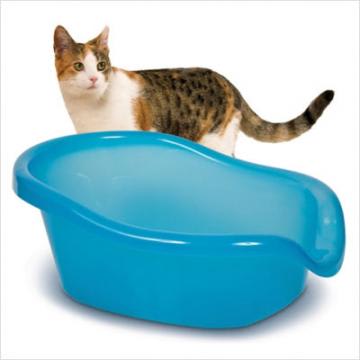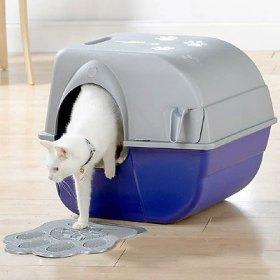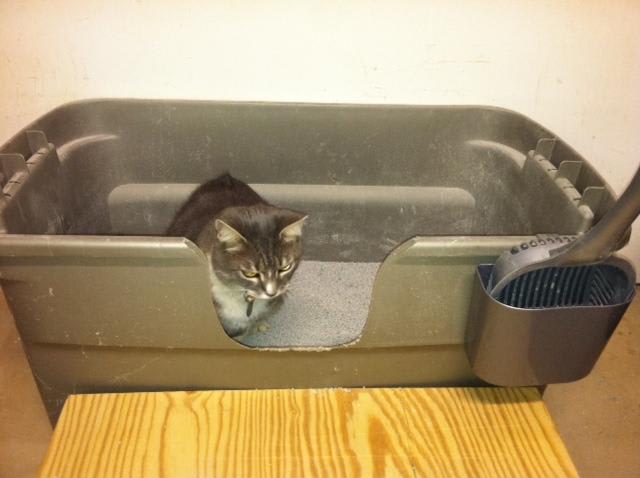
Learn different ways to keep your cat happy using the litter box.
Cats are wonderful to share our homes with, unless they start treating our homes as their bathroom. While most cats are very content to use the litter box for their eliminations, there are a variety of reasons why a cat may stop using the litter pan.
The first and most important question is whether the cat is eliminating outside the box because of a medical problem or because of a behavioral problem. A complete physical examination is the first place to begin. When we see patients with urinary problems at the Animal Hospital of North Asheville, we ultrasound the bladder to check for bladder stones or abnormalities of the bladder wall, and we collect a urine sample with a sterile needle into the bladder to determine if there is an infection, crystals, or evidence of cystitis. We check for signs of constipation if there are defecation problems. For all elimination problems, we check for spinal pain, hip pain, or other orthopedic difficulties, which may make it difficult for the cat to get into the litter pan or to get to the part of the house where the pan is located.

Another very important part of evaluation of cats for elimination problems is to closely observe behaviors. In a multi-cat household, which cat is going outside the box? Where is it occurring in the home? What is the cat’s posture when he’s urinating outside the box? Is he squatting or standing? Is there a large volume of urine or small quantities? Is it just urine, just stool, or both? All of this information can help us to narrow down the cause of house soiling.
Let’s say that we’ve determined through physical exam and diagnostic tests that behavior is the most likely cause of the problem. While it may seem like a cat could be acting out of spite or anger, most cats who don’t use the litter box actually don’t like something about the box.
What could be wrong?
- Cleanliness: Some cats are very meticulous about the cleanliness of their litter pans. It is recommended that a multi-cat household should have one litter pan per cat, plus one more. The litter should be scooped every day, and dumped once a week then cleaned with soap and water. Don’t use disinfectants, since some cats don’t like the smell and will avoid the box, and some disinfectants are toxic to cats (but not dogs or humans). Also, most cats don’t like litter pan liners.
- Location: Several boxes next to each other are the same as having one big box. Some cats prefer privacy, while others prefer to be out in the open. There should be an opportunity to be away from the other cats, since some assertive cats use potty time as a chance to attack or harass the more timid cat in the family. Locate the boxes on different levels of the house, especially if there is an elderly cat in the household who might have problems with stairs. The litter box should not be next to the cats’ food and water, since cats don’t like to eat where they eliminate.
- The box: Litter boxes should be deep enough to provide 2-3 inches of litter over the bottom, and wide enough to move around in easily. The opening should be low enough to provide easy access for arthritic or painful cats. One good option is to purchase a large storage bin and cut an opening on one side to allow access. Most cats don’t like covered boxes (you’ll often see them poking their heads out of the box as they use it). Many cats like automatically scooping boxes, although the mechanism can be scary to some cats.
- The litter: Studies have been done to determine what kind of litter cats prefer, given a choice. The vast majority would rather use an unscented, fine granular scoopable litter. Cats are very sensitive to smells and to sensations under their feet. They don’t care if we like the smell of pine or perfume, if there was a coupon in the paper, or if we would rather use a different material. If you’re not sure what your cat’s litter preference is, try offering a “litter cafeteria,” with different texture options to try. You could offer a traditional clay litter, a scoopable litter, and one of the newer corn or wheat litters (for example). Your cat will tell you which one to stick with.
While you’re working on litter pan management, also take steps to make the soiled areas less desirable. Clean the areas thoroughly, using an enzymatic odor neutralizer like Anti-Icky-Poo, which is available at the Animal Hospital of North Asheville. If possible, prevent access to rooms or areas where the soiling has taken place without causing undue stress to your cat. For example, if your cat urinates on the bed but nowhere else, close the bedroom door. But if your cat sprays everywhere, confinement will cause more stress and likely increase the behavior. If these measures don’t help, your cat’s veterinarian can help suggest medications and other methods for management of more serious behavioral concerns.
We hope that these tips will help keep your cat happy, healthy, and easy to live with!

 Dr. Betsy and Dr. Dave's litterbox - with their cat Eddie inside. The litterbox is large with a step so that the cats can easily climb inside. (Eddie insisted we put this picture a the end of the article - he is mortified to be caught in such a pose!)
Dr. Betsy and Dr. Dave's litterbox - with their cat Eddie inside. The litterbox is large with a step so that the cats can easily climb inside. (Eddie insisted we put this picture a the end of the article - he is mortified to be caught in such a pose!)
11.2011
